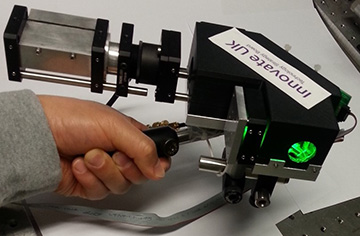
This handheld device for transmitting and receiving quantum cryptographic keys was built from off-the-shelf components, and could be miniaturized for use in a mobile device. [Image: Iris Choi, Oxford University]
Quantum key distribution (QKD), the gold standard in communications security, works well on long-distance transmissions between stable pieces of equipment. Over a Wi-Fi connection, with one end of a smartphone held at the wrong angle by a shaky hand? Not so much.
Recent work on a prototype device by a European research team could give future shoppers quantum-level security during point-of-sale wireless purchases (Opt. Express, doi:10.1364/OE.25.006784). The collaborators—based at Oxford University in the United Kingdom—studied the slight movements of human hands to develop a dynamic beam-steering scheme based on polarization.
Small movements, impressive results
The team, which included researchers from Nokia Technologies, Finland, and Bay Photonics Ltd., U.K., chose a reference-frame-independent QKD protocol, which relaxes the requirements for precision alignment of the transmitter and receiver. In the device they developed, six resonant-cavity LEDs (RCLEDs) with slightly overlapping spectra generate the qubits of the signal, with a green LED serving as the positioning beacon. The receiver, with the same passband filter as the transmitter and its own infrared beacon, collects photons through six multimode fibers that are connected to silicon avalanche photodetectors.
However, the transmitter and receiver won’t work if they can’t talk to each other long enough to exchange a secure quantum key. The Oxford team measured the slight jittering of handheld laser pointers, and based on the data, designed a micro-electro-mechanical-systems (MEMS) module that could detect the beacon from the opposite terminal and adjust its field of view accordingly.
For future success, size matters
The scientists built both devices from off-the-shelf components and tested them under ambient light conditions of about 400 lux. The transmitter and receiver exchanged secret keys at an average rate of 39 kb/s over a distance of 0.5 m.
With a transmitter that’s 25-cm long, the prototype system won’t fit into anyone’s pocket—at least not yet. The researchers suggest several ways to miniaturize the quantum key distribution terminals—fabricating the six RCLEDs on a single chip, for example, or incorporating photonic waveguides. Even so, economics and convenience will ultimately be the deciding factors in the widespread adoption of the technology.
